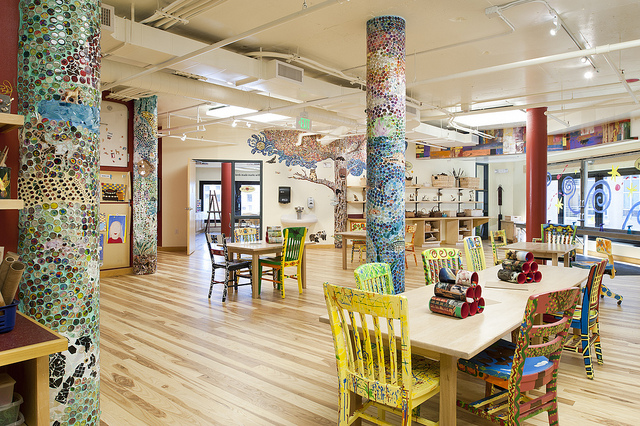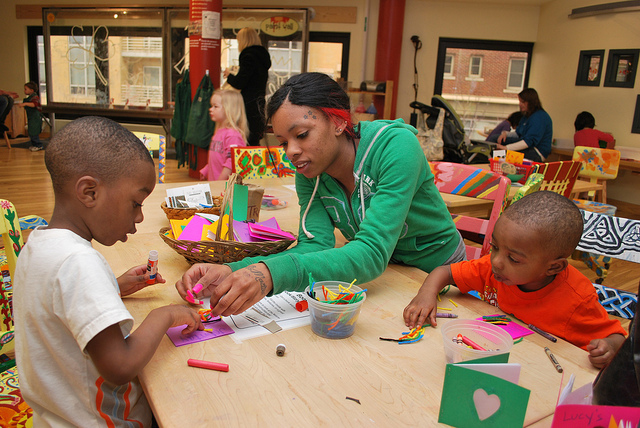Exhibits Case Studies
Madison Children's Museum100 North Hamilton Street
Madison, WI 53703
http://www.madisonchildrensmuseum.org
Brenda Baker (contact)
bbaker@madisonchildrensmuseum.org
Exhibit Title: Art Studio
Web Link to exhibit: http://madisonchildrensmuseum.org/exhibits/art-studio/
Project Budget:
Exhibit Square Footage:
Cost per square foot:
Art Studio
The Jim & Susan Bakke Art Studio is a drop-in area where children can create original works of art using different media, display their work, and interact with visiting artists on community-based projects. Children can sculpt, paint, draw, and weave; and make textiles, mixed media, photography, prints, digital media, and pottery, some on a rotating basis. In addition to the visual arts, acting, dancing, music making, and writing will have a presence, along with a monthly artist in-residence program. The Art Studio features a recycled station and nature station, both of which encourage kids to create art from found objects—whether they be manmade like bits of fabric and used plastic containers, or from elements from nature like sticks and leaves.

Distinguishing green features:
- The entryway was created by Madison artist Dale Malner from old paintings that used to hang in the corporate headquarters of Trek bicycle Corp. Dale accepted the museum’s challenge to make a 100 percent recycled entryway for the art studio.
- Refrigerator doors and old window frames have avoided the landfill and found a playful reuse in our rotating art gallery.
- Art studio chairs were purchased from University of Wisconsin SWaP (Surplus With a Purpose) and painted by museum visitors under the direction of artist-in-residence Katharine Goray. Tables were purchased from a Beloit College deconstruction sale, refinished, and shortened to accommodate young visitors.
- More than 13,000 Madison elementary school students created bottle cap art for these beautiful mosaics, designed by students from Shabazz City high school. Glass, stone, and small objects that are integrated into the mosaics were donated by museum members and friends
- A weaving station yields tapestries or kids' reading rugs that are sent to schools or nursing homes throughout the area. Tangible pieces of the Museum become woven in to the fabric of the larger community, fostering a sense of ownership.
- All the museum’s cabinets were made using a combination of local, sustainably harvested ash, and formaldehyde-free ash plywood. Cabinets were handmade by Bontrager Cabinetry in Dalton, Wis., as part of the museum’s commitment to patronize small businesses.
- Painting on the interactive paint wall is fun and helps eliminate some of the museum’s great need for paper, especially for working in large scale
- Many of the materials used for making art in the art studio and classroom are commonly thrown away or recycled: old egg cartons, cardboard tubes, yogurt containers, yarn, you name it. Their use inspires young artists to use available materials rather than buy new. Most supplies have been collected and donated by friends of the museum.
For more information regarding sustainable materials, visit the Build section of GreenExhibits website.

Further Reading:
- Institutional Sustainability Mission: http://www.greenexhibits.org/plan/mcm_sustainability_mission.php
- List of Sustainable Criteria for Contractors: http://www.greenexhibits.org/plan/guidelines_for_contractors.php
- “Risk Taking Isn’t Risky”, (pdf) Brenda Baker (Madison Children’s Museum), Hand to Hand, volume 26, Winter 2011 http://www.greenexhibits.org/local/HandToHand.pdf
- “Learning from Leopold and Seuss”, (pdf) Brenda Baker (Madison Children’s Museum), Guest Editor, Hand to Hand, volume 20, Spring 2006 http://www.greenexhibits.org/connect/H2HSpr06.Brenda1.pdf
- Seeing Green, (pdf) Jeremy Schoolfield, Fun World, The International Association of Amusement Parks & Attractions, June 2005 http://www.greenexhibits.org/connect/Seeing_Green_Jun05FW.pdf
- "The Sustainable Museum: It's Not Easy Being Green," (pdf) Brenda Baker and John Robinson, Hand to Hand, volume 14, Winter 2000 http://www.greenexhibits.org/connect/the_sustainable_museum.pdf


